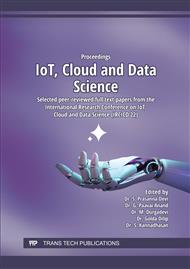[1]
Erzhou Zhu, Yuyang chen, Chengcheng Ye, Xuejun Li, and Feng Liofs-NN. An Effective Phishing Websites Detection Model Based on Optimal Feature Selection and Neural Network. IEEE ACCESS, 7, 2019, pp.no:73271-73284, doi:10:1109/ACCESS.2019.292065.
DOI: 10.1109/access.2019.2920655
Google Scholar
[2]
Brij, Gupta, Krishna Yadav, Imran Razzak, Konstantinos Psannis, Arcangelo Castiglione, Xiao Jun Chan. A novel approach for phishing URLs detection using lexical based machine learning in a real- time environment. ELSEVIER, 175, pp.no:45- 57.
DOI: 10.1016/j.comcom.2021.04.023
Google Scholar
[3]
P.A. Barraclough, G. Fehringer, J. Woodward. Intelligent Cyber-Phishing Detection for Online. ELSEVIER, Computers and Security, pp.no: 1-17, https://doi.org/10/1016/j.cose.2021.10213.
DOI: 10.1016/j.cose.2020.102123
Google Scholar
[4]
Nureni Ayofe Azeez, Sanjay Misrab, Ihotu Agbo Margaret, Luis Fernandez-Sanz, Shafi'I Muhammad Abdulhamide. Adopting Automated Whitelist Approach for Detecting Phishing Attacks. ELSEVIER, Computers and Security, pp.no: 1-18, https://doi.org/10/1016/j.cose.2021.102328.
DOI: 10.1016/j.cose.2021.102328
Google Scholar
[5]
Xiao, Xi, Wentao Xiao, Dianyan Zhang, Bin Zhang, Guangwu Hu, Qing Li, and Shutao Xia. Phishing websites detection via CNN and multi-head self-attention on imbalanced datasets., Computers & Security 108 (2021): 102372.
DOI: 10.1016/j.cose.2021.102372
Google Scholar
[6]
Wei, W., Ke, Q., Nowak, J., Korytkowski, M., Scherer, R., & Woźniak, M. (2020). Accurate and fast URL phishing detector: a convolutional neural network approach. Computer Networks, 178, 107275.
DOI: 10.1016/j.comnet.2020.107275
Google Scholar
[7]
Sahingoz, Ozgur Koray, Ebubekir Buber, Onder Demir, and Banu Diri. Machine learning based phishing detection from URLs., Expert Systems with Applications 117 (2019): 345-357.
DOI: 10.1016/j.eswa.2018.09.029
Google Scholar
[8]
Liu, D. J., Geng, G. G., Jin, X. B., & Wang, W. (2021). An efficient multistage phishing website detection model based on the CASE feature framework: Aiming at the real web environment. Computers & Security, 110, 102421.
DOI: 10.1016/j.cose.2021.102421
Google Scholar
[9]
El Aassal, Ayman, Shahryar Baki, Avisha Das, and Rakesh M. Verma. An in-depth benchmarking and evaluation of phishing detection research for security needs., IEEE Access 8 (2020): 22170-22192.
DOI: 10.1109/access.2020.2969780
Google Scholar
[10]
Alsariera, Yazan Ahmad, Victor Elijah Adeyemo, Abdullateef Oluwagbemiga Balogun, and Ammar Kareem Alazzawi. Ai meta-learners and extra-trees algorithm for the detection of phishing websites., IEEE Access 8 (2020): 142532-142542.
DOI: 10.1109/access.2020.3013699
Google Scholar
[11]
El Aassal, A., Baki, S., Das, A., & Verma, R. M. (2020). An in-depth benchmarking and evaluation of phishing detection research for security needs. IEEE Access, 8, 22170-22192.
DOI: 10.1109/access.2020.2969780
Google Scholar
[12]
Adebowale, Moruf Akin, Khin T. Lwin, and Mohammed Alamgir Hossain. Intelligent phishing detection scheme using deep learning algorithms., Journal of Enterprise Information Management (2020).
DOI: 10.1108/jeim-01-2020-0036
Google Scholar
[13]
Sahingoz, Ozgur Koray, Ebubekir Buber, Onder Demir, and Banu Diri. Machine learning based phishing detection from URLs., Expert Systems with Applications 117 (2019): 345-357.
DOI: 10.1016/j.eswa.2018.09.029
Google Scholar
[14]
Gualberto, Eder S., Rafael T. De Sousa, P. De B. Thiago, João Paulo CL Da Costa, and Cláudio G. Duque. From feature engineering and topics models to enhanced prediction rates in phishing detection., Ieee Access 8 (2020): 76368-76385.
DOI: 10.1109/access.2020.2989126
Google Scholar
[15]
Abroshan, Hossein, Jan Devos, Geert Poels, and Eric Laermans. Phishing happens beyond technology: The effects of human behaviors and demographics on each step of a phishing process., IEEE Access 9 (2021): 44928-44949.
DOI: 10.1109/access.2021.3066383
Google Scholar


